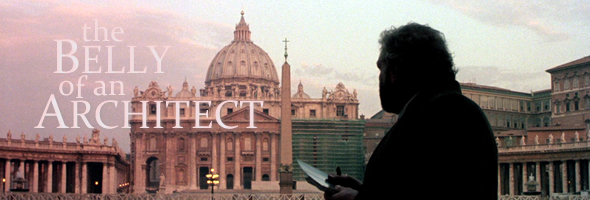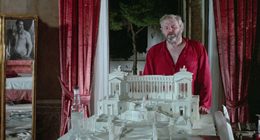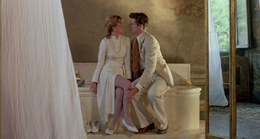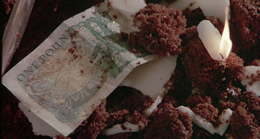

 productive architect Stourley Kracklite (Dennehy) arrives in Italy by train while still in the throes of passion with his wife,
productive architect Stourley Kracklite (Dennehy) arrives in Italy by train while still in the throes of passion with his wife,  Louisa (Sid and Nancy's Webb), they are welcomed with a gala dinner inaugurating his newest project, overseeing the research and restoration for an installation devoted to the French architect Etienne-Louis Boullée. Meanwhile nature has two surprises in store: Louisa is now pregnant, and Stourley is suffering from advancing stomach cancer. Stourley plunges headlong into his own private obsessions, repeatedly photocopying architectural designs, wandering the great buildings of Rome, and ignoring the needs of his wife who soon falls into the arms of one of Stourley's patrons, Caspasian Speckler (The Matrix Reloaded's Wilson), who plots with his sister, Flavia (Suspiria's Casini), to usurp all of the glory and potential cash from Kracklite's project.
Louisa (Sid and Nancy's Webb), they are welcomed with a gala dinner inaugurating his newest project, overseeing the research and restoration for an installation devoted to the French architect Etienne-Louis Boullée. Meanwhile nature has two surprises in store: Louisa is now pregnant, and Stourley is suffering from advancing stomach cancer. Stourley plunges headlong into his own private obsessions, repeatedly photocopying architectural designs, wandering the great buildings of Rome, and ignoring the needs of his wife who soon falls into the arms of one of Stourley's patrons, Caspasian Speckler (The Matrix Reloaded's Wilson), who plots with his sister, Flavia (Suspiria's Casini), to usurp all of the glory and potential cash from Kracklite's project.  simple, accessible manner (next to Drowning by Numbers, this would be the best place for Greenaway newcomers
simple, accessible manner (next to Drowning by Numbers, this would be the best place for Greenaway newcomers  to begin), largely ditching the eccentric peripheral characters who populate most of his other films (though you do get a rich patron who randomly grabs women's knees and drops dead in the middle of a reception). Most significantly, this was Greenaway's first film with a strong human pulse thanks to Dennehy's impassioned performance; not surprisingly, Greenaway's next three films were as much actors' showcases as they were aesthetic studies. Cinematographer Sacha Vierny returns again with his trademark gliding camera work, conjuring up some breathtaking visuals around various Roman landmarks. Even such simple devices as a child's top and billowing curtains become objects of visual delight through his lens, making his absence from world cinema now especially regrettable. Regular composer Michael Nyman had to step out of this project due to other commitments, but his position is more than ably filled with a stunning score from modern classical favorite Wim Mertens (with a handful of somber cues from Glenn Branca as well). If only Greenaway's post-Nyman films could have sounded this good!
to begin), largely ditching the eccentric peripheral characters who populate most of his other films (though you do get a rich patron who randomly grabs women's knees and drops dead in the middle of a reception). Most significantly, this was Greenaway's first film with a strong human pulse thanks to Dennehy's impassioned performance; not surprisingly, Greenaway's next three films were as much actors' showcases as they were aesthetic studies. Cinematographer Sacha Vierny returns again with his trademark gliding camera work, conjuring up some breathtaking visuals around various Roman landmarks. Even such simple devices as a child's top and billowing curtains become objects of visual delight through his lens, making his absence from world cinema now especially regrettable. Regular composer Michael Nyman had to step out of this project due to other commitments, but his position is more than ably filled with a stunning score from modern classical favorite Wim Mertens (with a handful of somber cues from Glenn Branca as well). If only Greenaway's post-Nyman films could have sounded this good!
 enhancement is really essential to catching all of the details within each shot. The stereo audio sounds solid, limited mainly to the propulsive score. The only extra is the Hemdale theatrical trailer, which has yet to surface
enhancement is really essential to catching all of the details within each shot. The stereo audio sounds solid, limited mainly to the propulsive score. The only extra is the Hemdale theatrical trailer, which has yet to surface  on any other release.
on any other release.  in book form like most Greenaway's other films), presskit materials, and sample sheet music.
in book form like most Greenaway's other films), presskit materials, and sample sheet music. 2K scan and restoration from the original 35mm camera negative. The prior HD presentation was already excellent so the difference here isn't tremendous, but the grain is managed better here and looks more natural while reds are more controlled and don't glow in a few spots like they do on the BFI (see fifth comparison grab below). The DTS-HD MA 2.0 English stereo track sounds as good as it always has with fine separation, and optional English SDH subtitles are provided. A new commentary track with Eugenio Ercolani and Greenaway obsessionist Tony Strauss covers everything you could possibly want to know about the production including Greenaway's reasons for distancing himself from it in later years, the numerous ties to his other films, the Italian production crew involved, the themes of architecture and the body, the merits of the score, and tons more. In "Stately Progress" (18m3s), still-busy editor John Wilson chats about his career path that led to the COI at the same time with Greenaway, the move to features with Draughtsman, working out the themes to this film upon seeing the footage which he couldn't see until it was all finished, the role of fine arts and especially drawing in this film and their others, and his overall working process with Greenaway which continued through Cook. "Caput Mundi" (28m31s) is an intriguing interview with architect Gianpaolo Ercolani (and some photogenic cats) about Greenaway's evolving relationship with Rome and its surroundings, his own introduction to Greenaway via Draughtsman, the boldness of casting Dennehy, the conceptual trademarks of Étienne-Louis Boullée's architecture, the heavy number of pick-up close shots done later in England, the doctrines behind the discipline, and the role of signature buildings here like the Pantheon. An insert booklet features an essay by Scout Tafoya, "The Cenotaph and Cake," placing this film in context with Greenaway's oft-stated theories about cinema and the ways one of its central architectural images reflects on the larger purpose of the story.
2K scan and restoration from the original 35mm camera negative. The prior HD presentation was already excellent so the difference here isn't tremendous, but the grain is managed better here and looks more natural while reds are more controlled and don't glow in a few spots like they do on the BFI (see fifth comparison grab below). The DTS-HD MA 2.0 English stereo track sounds as good as it always has with fine separation, and optional English SDH subtitles are provided. A new commentary track with Eugenio Ercolani and Greenaway obsessionist Tony Strauss covers everything you could possibly want to know about the production including Greenaway's reasons for distancing himself from it in later years, the numerous ties to his other films, the Italian production crew involved, the themes of architecture and the body, the merits of the score, and tons more. In "Stately Progress" (18m3s), still-busy editor John Wilson chats about his career path that led to the COI at the same time with Greenaway, the move to features with Draughtsman, working out the themes to this film upon seeing the footage which he couldn't see until it was all finished, the role of fine arts and especially drawing in this film and their others, and his overall working process with Greenaway which continued through Cook. "Caput Mundi" (28m31s) is an intriguing interview with architect Gianpaolo Ercolani (and some photogenic cats) about Greenaway's evolving relationship with Rome and its surroundings, his own introduction to Greenaway via Draughtsman, the boldness of casting Dennehy, the conceptual trademarks of Étienne-Louis Boullée's architecture, the heavy number of pick-up close shots done later in England, the doctrines behind the discipline, and the role of signature buildings here like the Pantheon. An insert booklet features an essay by Scout Tafoya, "The Cenotaph and Cake," placing this film in context with Greenaway's oft-stated theories about cinema and the ways one of its central architectural images reflects on the larger purpose of the story.![]()